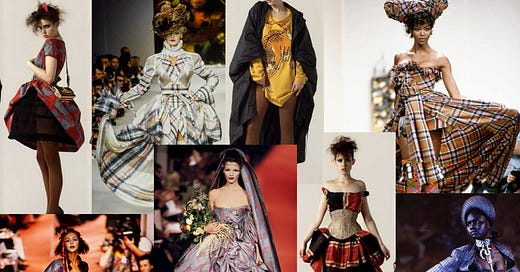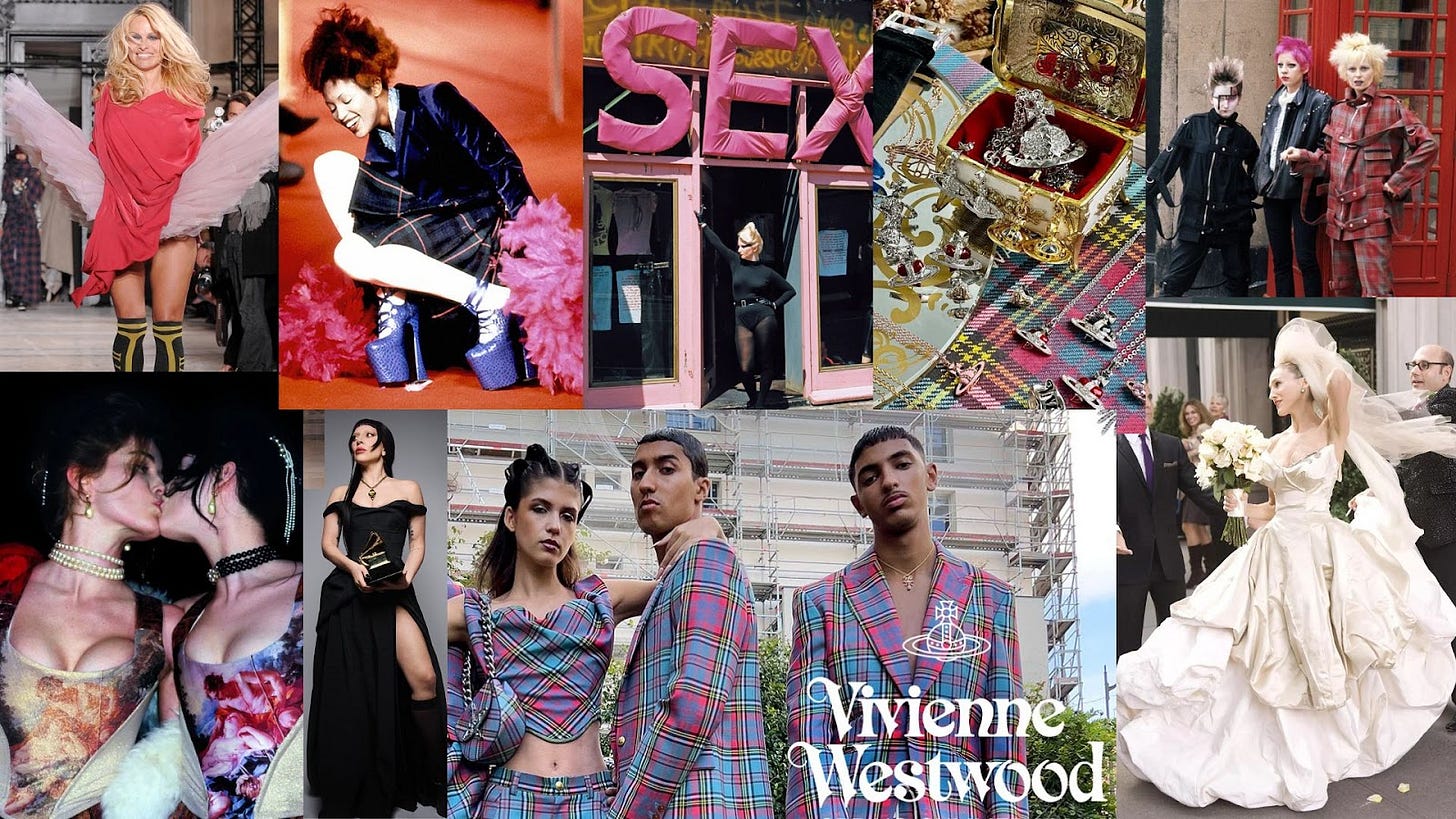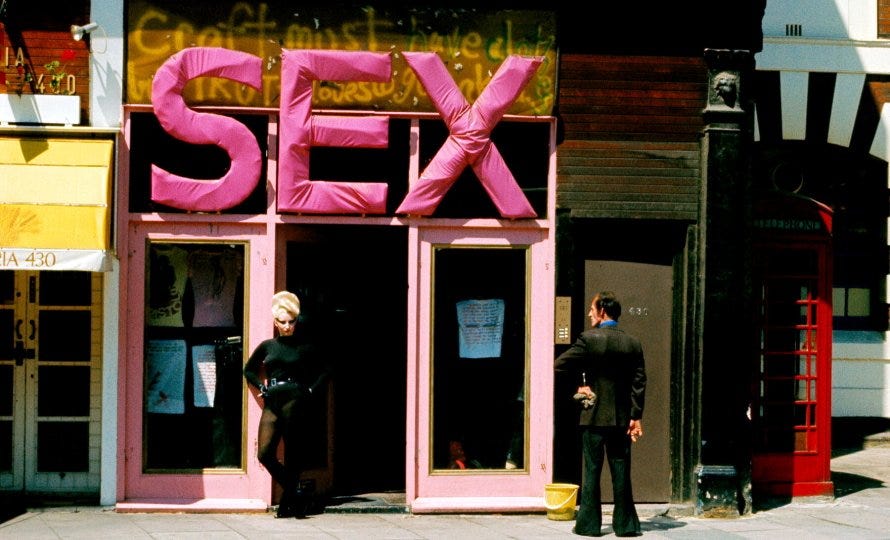She didn’t just design clothes—she disrupted systems.
Dame Vivienne Westwood took punk off the street and onto the runway, lacing rebellion into corsets and turning fashion into protest. Her language was loud. Her style, unapologetic. And her impact, global.
What began in a small shop on King’s Road became a global movement that reshaped fashion itself.
Gem unpacks the force behind the chaos, and reveals how one woman turned getting dressed into an act of revolution.
May her legacy continue to reign strong.
Happy reading,
Amarissa
Orrr….plug in and listen to this article on the Substack app. 🎧
Vivienne Westwood’s legacy is a tartan of rebellion- the worship of dress, woven with youth punk culture, intertwined with English history, and embellished by fetishism through the lens of self-expression. Not only a visual designer of garments, she reimagined the scope of fashion’s voice. She has always known who she was, but all she pleads is that society knows what she stands for.
The Punk Genesis
Upon London’s hazy backdrop, a young Vivienne Westwood leaned against a classic red telephone box, challenging authority with a cigarette and a plaid bondage set. The jangling of each of her movements was almost as potent as whatever slogan promoting equality adorned that day’s garb. The English fog was thick, and she was never lost in it.
Before her stardom, Westwood was an integrated member of the punk youth community in London. Altering her clothes and adorning them with proverbs of anti-establishment and pro-sustainability defined her mindset upon first glance of a stranger. Not hung up on the bohemian hippies of the ‘60s, she was a true rebel reveling in the grit of the ‘50s.
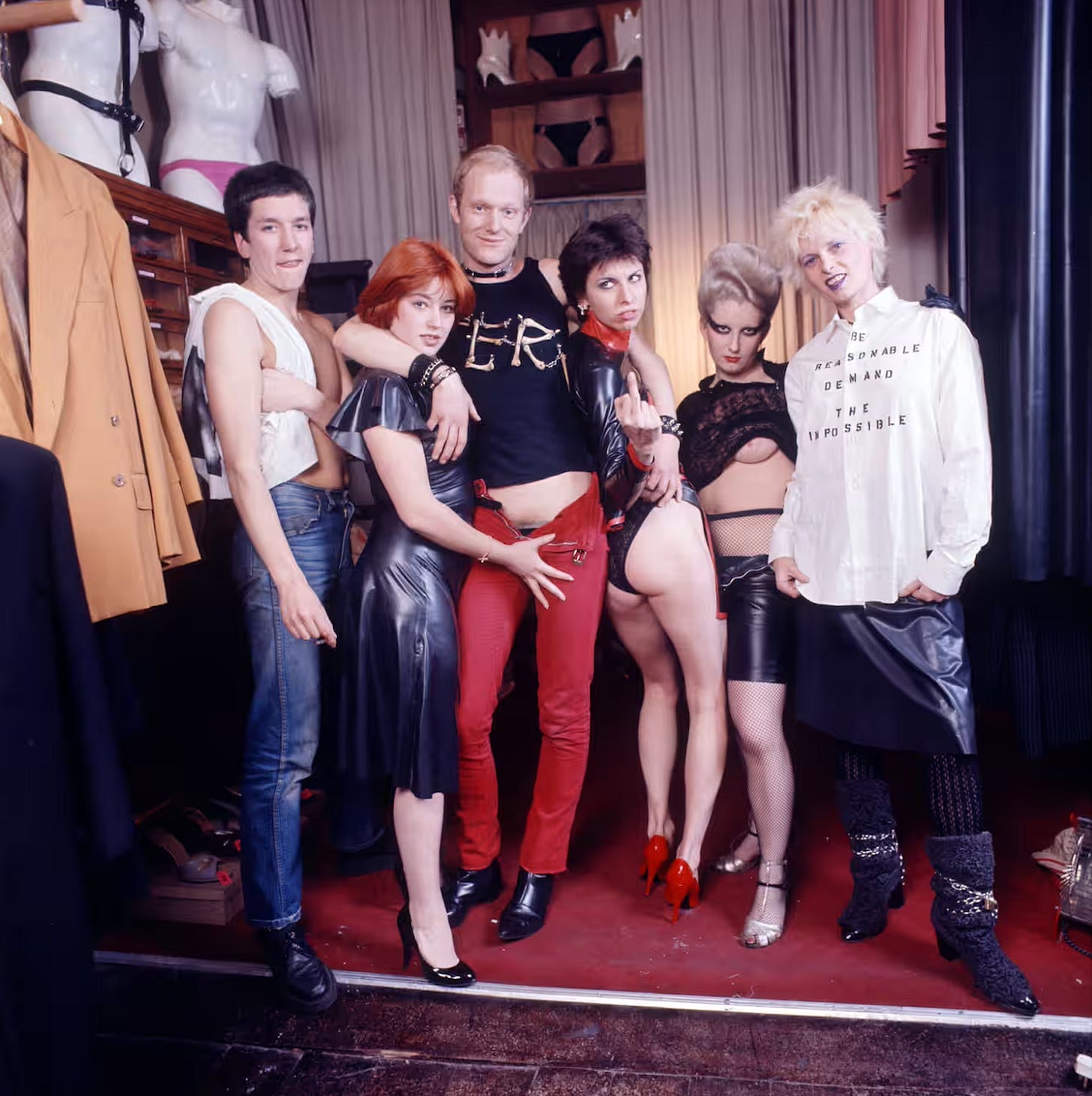
When her reach was only arm’s length, Westwood already knew what she believed, and her siren’s song of fashion entranced the sailors of like minds. She used her designs to communicate her expectations of society and absorb the outcasts.
Her work declared to the disillusioned, drawing in those alienated by the mainstream. Westwood’s world was a way of life: representational of those unrepresented. She has been anti-fascist, eco-conscious, and promotional of mindful consumption until all of society will walk her runway.

Birth of a Brand
Already styling herself, and designing and making Teddy Boy clothes, Westwood was an established designer with a clandestine clientele. In creative partnership with Malcolm McLaren (a band promoter) in 1971, the ribbon was cut on their first boutique, Let it Rock. The shop went through many phases and more garments, renamed Too Fast to Live, Too Young to Die as it became a pitstop for bold-lipped moto chicks and leathery-gelled greasers.
Oddities who connected with their community through fashion inhaled this lifestyle. While niche, the store was not event wear. In 1974, it became Sex—“rubberwear for the office.” Fetishism and latex for the day to day, clubwear parading as professionalism, it was a statement rejecting conformity to any dress code but one’s own.
Renamed once more to Seditionaries, the brand gained devotees as they dressed the Sex Pistols via manager McLaren. This rebrand embodies esoteric bondage and sexuality as D.I.Y. fashion. According to mass media, this style was labeled definitively as “Punk Rock”.
As punk began its heavenly ascent to mainstream, the emporium underwent its final reworking, becoming Worlds End eternally. The collective is currently an archive of renowned Westwood pieces produced with leftover fabric. They are exclusive and vary in quantity, as products are created with sustainability in mind.
A Fashion House is Built (1980s)
Initially, garments premiered in their boutique, but as their artistry was recognized, Westwood and McLaren were realized on the runway. In 1981, swashbuckling down the catwalk were jewel tones on fluttering button-ups, inaugurating their first official collaborative show Pirate.
They introduced future recognized traits of the brand in the public eye: reworking historical garments, asymmetry, undergarments as outerwear, and dynamic story-telling. Garments tattered and worn from the fantasy journey pre-runway was an emblem of each collection ever after.

A few more years of successful shows and solidified branding went on, and in 1986, Westwood developed her logo. It was an insignia representative of British tradition and its translation into the future. Inspired by the crown jewels of the United Kingdom and existentialism in the context of outer space, the orb was the celestial divine, perpetually adorning her pieces.
The Avant-Garde Aristocracy (Early 1990s)
The ‘90s dawned, and Westwood’s new muses were bathed in sunlight. The decade turned, and her main inspirations shifted from freaks in fetishwear to emulation of London royalty through caricature. The collections varied in theme from mythology, to the Age of Enlightenment, to differing eras of dress as time travel, and textiles that mimicked painting techniques.
Honorably, Portrait was a worship of art through corsetry. The 18th-century decor inspired gold trim on structured bodices that worshiped the female form. Rococo ornamentation was evident in detailing as pale tans and blush pinks and hair piled high (bringing models close to the angels).
The show’s metaphorical spotlight was shown upon models Denis Lewis and Susie Bisque during their iconic girl-on-girl kiss at the end of the runway. The performance was more than an act; it was defiant of heteronormativity through a foreground of intimacy.

This era, like the others, did not stray from Vivienne’s vision but interpreted it further. Exposed tights, askew styling, and juxtaposing fabrics like leather within tulle were translated through the first person’s view of lewdness. Models were elevated on excessive platforms and frivolous heels, giving each one the personal illuminated pedestal that they deserve.
Alternative communities often plod in platforms, a look that the brand further normalized, coinciding with the elevated Mary Janes and sandals walking over popular trend of the ‘90s. This style of footwear elongated legs on people of all identifications. Westwood’s warriors- gods and goddesses- demanded attention with just a step.
Perverse Plaids (Late 1990s)
Westwood is presently known for her plaids (a punk staple), but this is when she developed her signature tartan. It was fabricated in tandem with her clan, MacAndreas, which was officially recognized. The colors were curated and intentional, a pattern used recognizably in her bags, dresses, blazers, and so forth, in a way that was deliberately not casual. She then continued to open boutiques across London, expanding to flagships in New York City and Tokyo.
Anglomania (FW 1993) combined elaborate British tailoring with exaggerated French proportions. It featured the namesake tartans, lucious furs, versatile kilts, and royally puffed sleeves. Mid-show, Naomi Campbell famously fell in the 12” Ghillie platform heels in faux croc blue leather. The tumble transcended the fashion atmosphere, becoming a symbol in pop culture.
Designers have brazenly asked her to recreate the moment, and many recognize the “faux pas” without even connecting it to Westwood due to the mass of generated press. With a self-aware giggle and false shame, Campbell stood up and finished her strut, a mirror of Westwood’s dedication to authenticity.
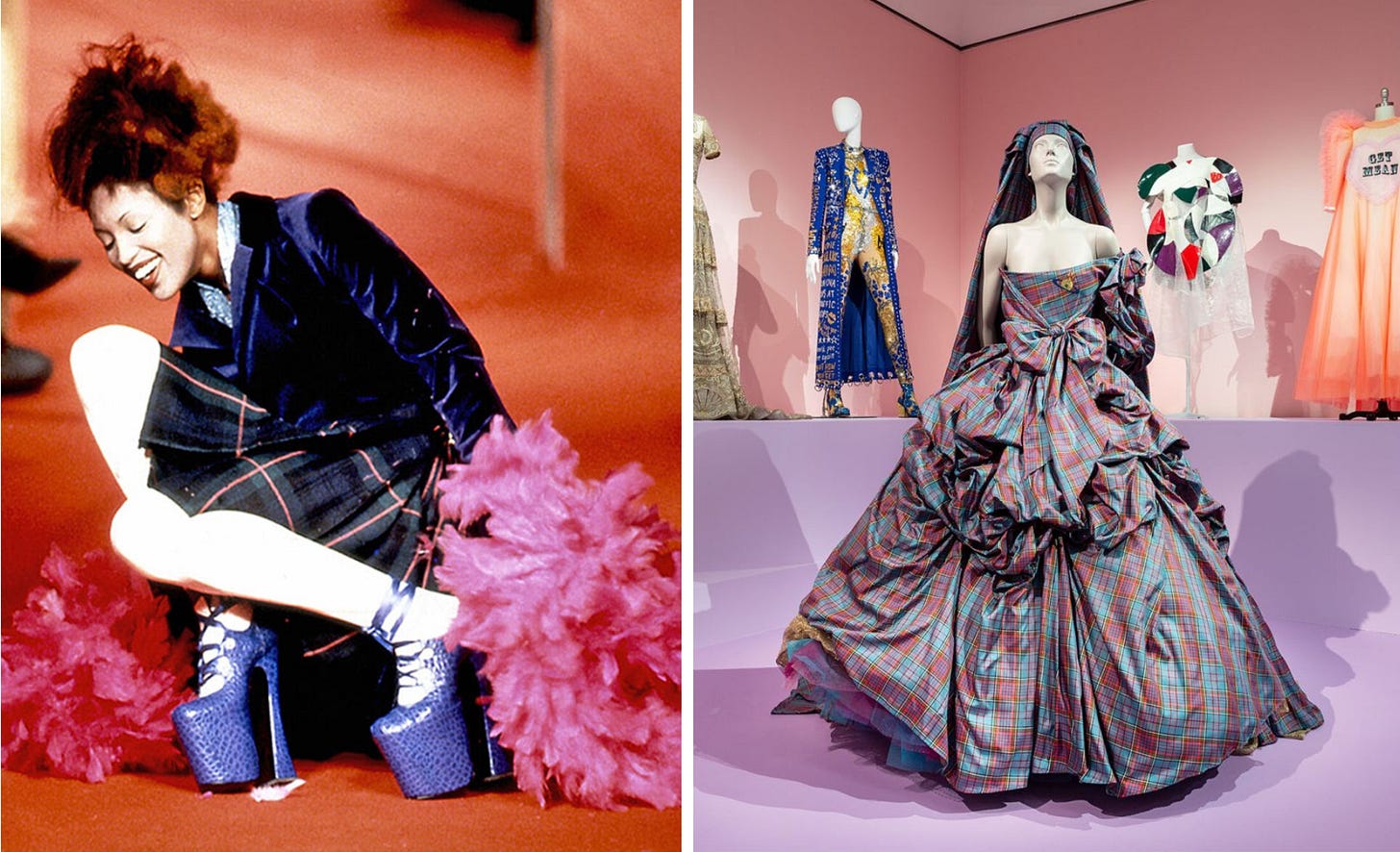
As the tartan-fever temperature rose, it officially solidified and separated into a distinct diffusion line that embodied Westwood’s youthful love of draping and tailoring. The show’s finale was an epic: Kate Moss donned a fully plaid wedding gown fit for a bride in Celtic heaven Albios.
What Westwood Represents (Early 2000s)
Until there is peace and truth, Westwood will not be silenced. The consistency with her sustainability efforts is unlike any other, especially in high fashion. Climate Revolution, Westwood’s activist team, was founded, and she continually donated to accredited organizations like Cool Earth.
Themes of sexual taboos, the female form as a celestial body, and visible intimates that represent emotional nakedness, all collectively undermine and redefine the idea of the ideal woman. In the context of sustainability, she preached recycling and reduction of waste, encouragement to make and alter your clothes, saving and salvaging the rainforest, and anti-fracking, all normalizing the abnormal of candidly exploring impact.

This chapter leaned less on historical dress as garment structure and more on her fashion as an amplifier for the world matters she was passionate about. Her campaigns aimed to dig a slippery rabbit hole that her disciples would willingly throw themselves into with their own inspired activism. She reflected on past events as a cautionary tale that can be utilized to raise awareness.

Is Vivienne Westwood the Queen of Punk?
Like all subcultures, what defines it varies on who is asked, where they are, and their experience adjacent to or within it. It is amorphous and defies definition. The fundamentals of punk are commonly recognized as a movement and musical genre that is based on anti-establishment ethos, handcrafting your belongings, and freedom of expression.
Westwood has gone from a punk youth herself, to creating work integrating these aspects of her culture, to evolving into a major fashion house with a devout homage to the community. By her hand and mind, rebellion was redefined as a spectacle and art form. Despite her present successes with her brand, her impact in the punk community is irrefutable.
She illuminated elements of the culture to mainstream audiences, like plaids affiliated with rebellion, modifications using safety pins and patches, bondage styles embracing kink through hardware, and challenging the norm by expressing individuality.
Her utilization of societal evangelism in her craft is also inherently punk. Her values never faltered, and each show was informative while also being a call to action. Her name paved an ember-laden path for politics in couture.

Dame Vivienne Westwood has been provocative not to gain attention but because it is her voice. Her work is not a costume, however theatrical. It recognizes her past and implores the youth to consider it when they become the future, as she did. Westwood’s career is a protest, an archive, and an inspiration for activism as couture.
Contributing edits by our Winter ‘25 Student Writing Program editor, , with final oversight & edits by Amarissa.
today’s writer…
Gem is a participant in Fashion Talk's Winter 2025 Student Writing Program. Aligned with our mission to uplift emerging voices in the fashion industry, we’re excited to share their fresh and insightful perspective with our community.
You can get to know them here.
connect with us: IG → pinterest → twitter → bluesky


